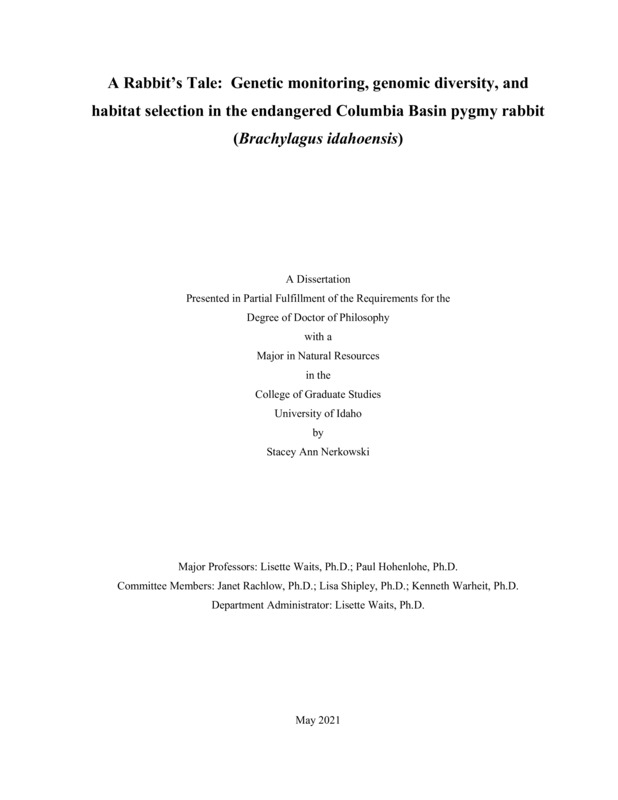A Rabbit’s Tale: Genetic monitoring, genomic diversity, and habitat selection in the endangered Columbia Basin pygmy rabbit (Brachylagus idahoensis)
Nerkowski, Stacey Ann. (2021-05). A Rabbit’s Tale: Genetic monitoring, genomic diversity, and habitat selection in the endangered Columbia Basin pygmy rabbit (Brachylagus idahoensis). Theses and Dissertations Collection, University of Idaho Library Digital Collections. https://www.lib.uidaho.edu/digital/etd/items/nerkowski_idaho_0089e_12125.html
- Title:
- A Rabbit’s Tale: Genetic monitoring, genomic diversity, and habitat selection in the endangered Columbia Basin pygmy rabbit (Brachylagus idahoensis)
- Author:
- Nerkowski, Stacey Ann
- ORCID:
- 0000-0003-1486-577X
- Date:
- 2021-05
- Keywords:
- Columbia Basin Pygmy Rabbit Genetics Conservation Reserve Program Genetic Monitoring Habitat Selection Noninvasive Genetic Sampling Pygmy Rabbit Genomics
- Program:
- Natural Resources
- Subject Category:
- Wildlife conservation; Genetics; Conservation biology
- Abstract:
-
Loss and fragmentation of habitat led to the near extirpation of the disjunct pygmy rabbit (Brachylagus idahoensis) population in the Columbia Basin of Washington state. In 2003, the Columbia Basin pygmy rabbits was listed as an endangered distinct population segment under the United Stated Endangered Species Act. In 2001, 16 Columbia Basin pygmy rabbits were taken from the last remaining population in Sagebrush Flat wildlife area and used to start a captive breeding program. To counteract the high levels of inbreeding among the rabbits, a genetic rescue was performed by adding 4? pygmy rabbits from Idaho. In 2011, with the main goal of reintroduction of rabbits back to the state of Washington, the captive breeding program transitioned to on-site breeding, where genetic and demographic rescue was performed by introducing an additional 100ish pygmy rabbits from regional populations across the species range. Since the first translocations in 2012, over 1900 mixed-ancestry rabbits have been translocated into the Sagebrush Flat wildlife area. Two additional populations were established later in Beezley Hills Preserve (2017) and Chester Butte wildlife area (2018). Monitoring of these translocated populations of endangered species rabbits is crucial for evaluating and informing conservation strategies to maximize the chances of a successful recovery. We used noninvasive invasive genetic sampling to evaluate demographic and population genetic parameters on three reintroduced populations of pygmy rabbits over 8 years (2012-2020). For each population, we evaluated spatial distribution, apparent survival rates, post-release dispersal distance, genetic diversity, reproduction, and the persistence of Columbia Basin ancestry. For five groups of pygmy rabbits maintained in large breeding enclosures within native habitat, we estimated genetic diversity and Columbia Basin ancestry from 2012-2020. Over the course of this study, 1479 rabbits (Sagebrush Flat), 461 rabbits (Beezley Hills), and 38 rabbits (Chester Butter) were reintroduced by a cooperation between state and federal agencies. Through winter and summer monitoring surveys, we identified 168 released rabbits and 420 wild-born rabbits in Sagebrush Flat, 13 released rabbits and 2 wild-born in Beezley Hills, and 16 released rabbits in Chester Butte. Survival differed across years and was positively influenced by release date, release weight, and heterozygosity (Chapter 1). To better understand the mixed-ancestry rabbits within Washington, we needed to evaluate the genomic diversity across the species’ range. We used restriction site-associated DNA sequencing (RADseq) approach on 123 rabbit samples, including pure Columbia Basin pygmy rabbits, to identify single nucleotide polymorphisms (SNPs) and determine population genetic structure across the pygmy rabbit range, assess the distinctiveness of the Washington population, and test for genomic signatures of adaptive divergence among populations. Using 12,084 SNPs, we identified four distinct genetic groups: (1) Washington, (2) Great Basin (California, Nevada, Idaho, Montana), (3) northern Utah/Wyoming and (4) southern Utah. The Washington population was most divergent compared to the other genetic groups, reinforcing its federal protected status as a distinct population segment. Identifying genetic markers for ancestry from the multiple pygmy rabbit populations will help monitor variation in the admixed Washington population and assess the consequences of genetic rescue efforts (Chapter 2). Through winter monitoring surveys performed between 2012 and 2020 on the wild population at Sagebrush Flat wildlife area, we observed a shift in spatial distribution of pygmy rabbit burrows from native shrub-steppe habitat (Sagebrush Flat) to Conservation Reserve Program (CRP) habitat that had been revegetated with native shrub-steppe flora in the mid-1990s. We compared vegetative and soil characteristics to test hypotheses about factors driving pygmy rabbit habitat selection. We identified that shrub canopy cover, living canopy cover, and composition of the canopy (living sagebrush) were higher in occupied sites and sagebrush was more nutritious in CRP habitat. These findings can help guide management strategies and provide the necessary tools to identify suitable habitat for future release efforts for the endangered Columbia Basin pygmy rabbit and have demonstrated the value of habitat restoration efforts like CRP (Chapter 3).
- Description:
- doctoral, Ph.D., Natural Resources -- University of Idaho - College of Graduate Studies, 2021-05
- Major Professor:
- Waits, Lisette P; Hohenlohe, Paul A
- Committee:
- Rachlow, Janet L.; Shipley, Lisa A.; Warheit, Kenneth I.
- Defense Date:
- 2021-05
- Identifier:
- Nerkowski_idaho_0089E_12125
- Type:
- Text
- Format Original:
- Format:
- application/pdf
- Rights:
- In Copyright - Educational Use Permitted. For more information, please contact University of Idaho Library Special Collections and Archives Department at libspec@uidaho.edu.
- Standardized Rights:
- http://rightsstatements.org/vocab/InC-EDU/1.0/

